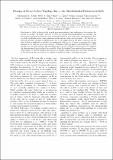Changes of Fermi surface topology due to the rhombohedral distortion in SnTe
View/
Date
21/10/2020Author
Grant ID
PLP-2015-144
URF/R/180026
2016-006
Metadata
Show full item recordAbstract
Stoichiometric SnTe is theoretically a small gap semiconductor that undergoes a ferroelectric distortion on cooling. In reality however, crystals are always nonstoichiometric and metallic; the ferroelectric transition is therefore, more accurately described as a polar structural transition. Here, we study the Fermi surface using quantum oscillations as a function of pressure. We find the oscillation spectrum changes at high pressure due to the suppression of the polar transition and less than 10 kbars is sufficient to stabilize the undistorted cubic lattice, this is accompanied by a large decrease in the Hall and electrical resistivities. Combined with our density functional theory calculations and angle-resolved photoemission spectroscopy measurements, this suggests the Fermi surface L pockets have lower mobility than the tubular Fermi surfaces that connect them. Additionally, we find the unusual phenomenon of a linear magnetoresistance that exists irrespective of the distortion that we attribute to regions of the Fermi surface with high curvature.
Citation
O'Neill , C D , Clark , O J , Keen , H D J , Mazzola , F , Marković , I , Sokolov , D A , Malekos , A , King , P D C , Hermann , A & Huxley , A D 2020 , ' Changes of Fermi surface topology due to the rhombohedral distortion in SnTe ' , Physical Review. B, Condensed matter and materials physics , vol. 102 , no. 5 , 155132 . https://doi.org/10.1103/PhysRevB.102.155132
Publication
Physical Review. B, Condensed matter and materials physics
Status
Peer reviewed
ISSN
1098-0121Type
Journal article
Description
Funding: UK EPSRC grants EP/P013686/1 and EP/R013004/1 (CDON and ADH) and the Royal Society (PDCK) and the Leverhulme Trust (PDCK and FM). We also acknowledge PhD studentship support from ES-PRC EP/L015110/1 (HDJK) and EP/K503162/1 (OJC) and via the International Max-Planck Research School for Chemistry and Physics of Quantum Materials (IM).Collections
Items in the St Andrews Research Repository are protected by copyright, with all rights reserved, unless otherwise indicated.

